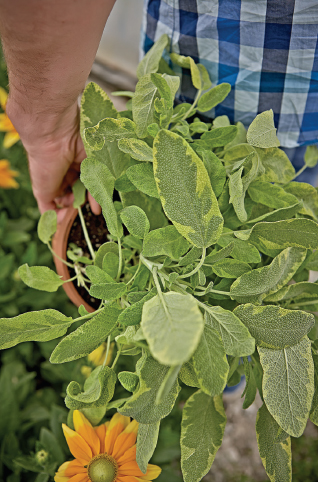
Drying Herbs at Home
Many of the preparations in this book are made with dried herbs, so if you’re growing your own, you’ll need to get comfortable with the drying process. For the most part this is quite easy—sage and parsley are a snap—but others such as basil and mint can be more challenging.

Start by harvesting herbs in late morning, after the dew has evaporated. Remove any dead or damaged leaves. If the foliage is dirty you can give your herb harvest a rinse under cold running water. Shake off the excess water and spread the herb on a paper towel or cloth and leave until all the moisture has evaporated. Then follow one of these three drying methods:
To Air-Dry
Make small bundles by tying the stems with string or twine. The bundles shouldn’t be too large, and you should keep them loose to allow for greater airflow. Hang the bundles out of direct light. UV rays from the sun will discolour and reduce the potency of many herbs. You can also place them loosely in paper bags before hanging. This will help shade them and keep them dry and dust-free. Hang them in a closet, attic, garage, or any room that is dry, remains above freezing, and is usually dark.
Another option is to use drying trays (best described as window screens). The holes in the screen help increase airflow. Arrange herbs in a single layer (do not crowd them) on the trays and place in a dry, warm location out of direct light until the herbs are thoroughly dry and brittle (usually 2 to 4 weeks).
To Oven-Dry
Arrange the herbs in a single layer on a baking sheet lined with parchment paper. Spread them out evenly, ensuring they’re not crowded. Bake in the oven at the lowest temperature setting for 1 hour. Then turn off the heat and leave the herbs in the oven overnight.
To Dry in the Microwave
Arrange a single layer of herbs between two paper towels and place in a microwave set on high for 1 to 2 minutes (you may need more or less time depending on the herb you are drying), until completely dried and brittle. If the herbs are not brittle, heat for another 30 to 40 seconds. Repeat as needed.
How Do You Know When Herbs Are Dried?
That depends on the method you used and the thickness of the leaf: Each herb dries differently. As a general rule, you know an herb is dried when it is brittle and crumbles when touched.
Dried herbs should always be stored out of direct light, moisture, and extreme heat. Some can be stored for up to a year in the right conditions. See the recommendations listed under each plant in this book.

